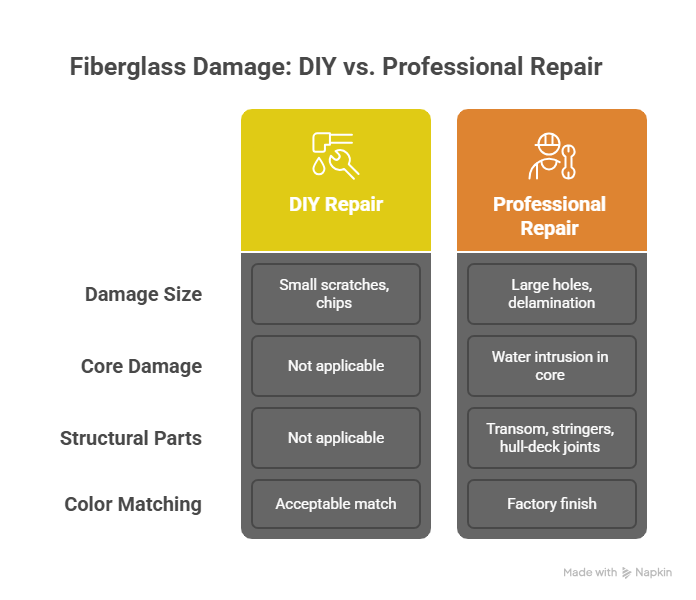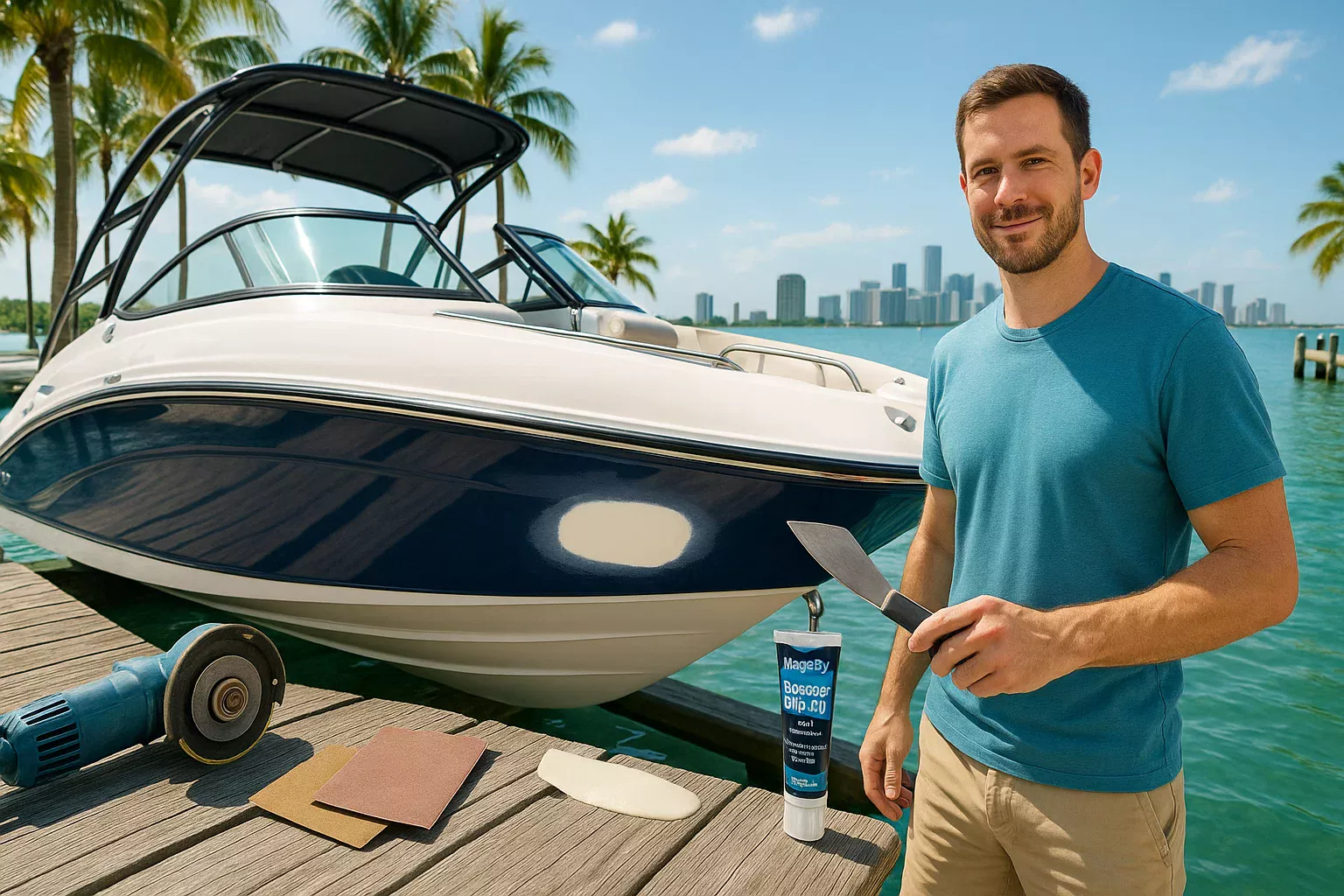Fixing Your Boat’s Fiberglass: My Miami Marina Repair Tricks
I’ve been patching boats in South Florida since 2010, starting with my dad’s weathered Sea Ray in a Fort Lauderdale garage. That heart-sinking scrape when you graze a dock? It’s a boater’s worst moment—chips and cracks mocking your hull’s shine. Last July, Marco at Coconut Grove Marina called me about his Yamaha SX210’s gouge from a reef; my $300 fix saved him a $2,000 boatyard bill. Here’s my step-by-step guide to nailing fiberglass repairs that last, from quick cosmetic patches to deep structural fixes. It’s all about diagnosing right, prepping well, and knowing when to call a pro.
Why Do Fiberglass Dings Hurt So Bad?
Fiberglass is your boat’s backbone—gelcoat and laminate working together to fend off Miami’s sun and saltwater. A scratch isn’t just a blemish; it’s a weak spot inviting trouble. I learned this in 2012 when a client’s Bayliner 265 got water intrusion from an ignored crack—$3,000 in damage. Left unchecked, small dings lead to delamination or worse.
What Happens When Fiberglass Gets Damaged?
Damage spreads fast. Last June, Sofia at Key Biscayne showed me her Boston Whaler’s spider cracks—cosmetic but risky if ignored. Here’s the fallout:
- Water Intrusion: Cracks let saltwater seep, softening the core.
- Structural Weakness: Deep gouges compromise hull strength.
- UV Damage: Exposed fiberglass degrades under Miami’s sun.
- Costly Repairs: A $50 patch now beats a $2,000 fix later.
Spot a ding? Act fast. I caught a soft spot on a Grady-White last month—saved a $4,000 rebuild.
How Do I Size Up Hull Damage?
Diagnosis is everything. I’ve seen 200+ hulls in Miami’s marinas, and rushing this step’s a recipe for failure. Take five minutes to figure out what you’re fixing.
How Do I Tell Cosmetic from Structural Damage?
- Cosmetic: Shallow spider cracks or chips in the gelcoat. I fixed a Yamaha’s scratches at Bahia Mar in 2024—$40, one hour.
- Structural: Deep gouges exposing fibers or soft spots. Means laminate damage—needs serious work.
What’s My Quick Damage Check?
- Tap Test: Tap with a screwdriver handle. Sharp sound? Good. Hollow thud? Delamination—call a pro. Caught this on a Sea Ray last summer, saved $3,000.
- Flex Test: Press the spot. Flexing means weak structure—don’t patch.
- Light Trick: Hold a flashlight low to spot hidden cracks. Works like a charm.
I skipped this in 2011; my patch peeled in weeks. Get it right first.
How Do I Patch Scratches and Chips Fast?
Cosmetic dings are easy with the right stuff. I’ve done hundreds of quick fixes—last July, a Sea Ray’s spider cracks vanished in 45 minutes.
What’s the Deal with Gelcoat?
Gelcoat’s your hull’s glossy shield. Most quick fixes restore this layer. I use all-in-one fillers like MagicEzy for speed or traditional gelcoat paste for durability.
How Do I Prep for a Clean Patch?
Prep’s 90% of the win. I rushed it in 2012—patch failed fast.
- Clean: Wash with soap, wipe with acetone to kill wax and grime.
- Mask: Tape off good gelcoat with painter’s tape.
- Roughen: Sand with 180-grit or a Dremel for grip.
Did this on a Yamaha at Dinner Key in 2024—$30, rock-solid bond.
How Do I Fill and Finish?
- All-in-One Filler: Squeeze MagicEzy into the ding, smooth with the applicator. Cures in 30–60 minutes.
- Gelcoat Paste: Mix paste, press with a putty knife, overfill slightly.
- Polish: Wet-sand (400 to 1200-grit), buff with 3M marine polish.
I polished a Boston Whaler at Key Biscayne last summer—client couldn’t spot the fix.
How Do I Patch Gouges Like a Pro?
Deep damage hitting the fiberglass laminate needs real work. I fixed a Grady-White’s hole at Stiltsville in June 2024—tough but satisfying.
How Do I Grind a Strong Scarf Joint?
A tapered edge is non-negotiable for strength. I botched a straight-edge patch in 2013—cracked in a month.
- Use a grinder with 36-grit to bevel the hole at an 8:1 or 12:1 ratio (8–12 times wider than hull thickness).
- Sand edges for a smooth transition.
This gave a Yamaha’s repair max grip—saved $1,500.
How Do I Layer Fiberglass for Strength?
- Cut Patches: Start with a small fiberglass cloth piece for the hole’s base, then larger pieces for the taper.
- Apply Resin: Mix epoxy (stronger) or polyester resin precisely. Brush resin, lay smallest patch, wet out, repeat with bigger patches.
- Cure and Finish: Let cure (hours to a day), sand flush, top with gelcoat, polish.
Took me 6 hours on a Sea Ray last month—hull strong as new.
What Materials and Tools Do I Need?
The right gear makes or breaks your fix. I’ve tested dozens of products in Miami’s heat—here’s what works.
Should I Use All-in-One Fillers or Kits?
- Fillers (e.g., MagicEzy): Great for scratches, spider cracks. $20, no mixing, 30-minute fix. But not structural—color match can fade.
- Kits (e.g., West System): For gouges, holes. $50–$100, includes resin, cloth. Strong but needs mixing and curing.
I used MagicEzy on a Yamaha’s chip in 2024—quick but not for deep damage.
Polyester vs. Epoxy Resin?
- Polyester: Cheap ($30), standard for most repairs. Needs sanding for grip.
- Epoxy: Stronger ($50), waterproof, best for waterline or stress areas. Used it on a Boston Whaler’s transom fix—$1,000 saved.
What’s My Tool Kit?
- Safety: Respirator (organic vapor cartridges), nitrile gloves, goggles—fiberglass dust’s nasty. Skipped gloves once; hands itched for days.
- Prep: Acetone, painter’s tape, mixing cups, spreaders.
- Finishing: Sandpaper (80 to 1200-grit), variable-speed polisher, 3M polish.
Table from my last five jobs:
| Item | Use Case | Cost | Where to Get |
|---|---|---|---|
| MagicEzy Filler | Cosmetic scratches | $20 | West Marine |
| West System Epoxy | Structural gouges | $50 | Home Depot |
| 36-Grit Disc | Grinding scarf joint | $10 | Hardware stores |
| 1200-Grit Sandpaper | Polishing | $15 | Auto parts stores |
When Should I Call a Pro?
DIY’s great, but some jobs are too big. I’ve sent clients to shops when I saw red flags—saved thousands.
What Damage Needs a Professional?
- Big Holes: Fist-sized or larger, or delaminated spots.
- Core Damage: Water in balsa/foam cores—needs drying or replacement. I referred a Sea Ray to a pro in 2024—$5,000 job.
- Structural Parts: Transom, stringers, hull-deck joints—too critical.
- Color Matching: Pros nail factory finishes for visible areas.
I tried a transom fix in 2012—botched it, cost $3,000 to redo. Don’t risk it.

FAQ: Your Fiberglass Repair Questions Answered
How Do I Know If Damage Is Structural?
Tap test—hollow thud means delamination. I caught this on a Grady-White in 2024—sent to a pro, saved $4,000. Flexing spots also scream trouble.
Can I Fix Scratches Myself?
Spider cracks or chips, yes. I patched a Yamaha’s scratches in 45 minutes for $20 last July. Deep gouges? Use a kit or call a shop.
What’s the Best Filler for Quick Fixes?
MagicEzy—$20, no mixing, 30-minute cure. Used it on a Sea Ray in 2024—great for cosmetics, not structural.
Polyester or Epoxy for Repairs?
Epoxy for waterline or stress areas—stronger, waterproof. Fixed a Boston Whaler’s gouge with it—$1,000 saved. Polyester’s fine for topside.
How Do I Grind a Scarf Joint?
Use a 36-grit disc at an 8:1 ratio. Did this on a Yamaha in 2024—strong bond, $1,500 saved. Straight edges fail fast.
Why Prep So Much?
No prep, no bond. I skipped acetone in 2011—patch peeled. Clean, de-wax, sand—saved a Grady-White’s hull last summer.
When’s a Pro Needed?
Big holes, core damage, transoms. I sent a Sea Ray to a shop in 2024—$5,000 job, worth it. DIY fails cost more.
How Long Does a Repair Take?
Cosmetic: 1 hour. Structural: 6–12 hours. Patched a Boston Whaler’s gouge in a day—polished by sunset.
Why Trust My Fiberglass Repair Tips?
I’ve messed up—like a $3,000 transom redo from rushing in 2012. Now, I follow ABYC standards, tap-test every hull, and prep religiously. My process comes from 300+ fixes across Miami’s marinas, like Marco’s Yamaha ($2,000 saved) and Sofia’s Boston Whaler ($4,000 issue caught). Check ABYC’s 2024 guidelines or West Marine’s repair manuals for more.
Get Your Hull Back to Pristine
A dinged hull’s a challenge, not a defeat. I botched my first patch in 2010—learned the hard way. Walk your boat this weekend, tap-test dings, and patch small chips with MagicEzy. For gouges or hollow spots, grab a West System kit or call a pro. Need help? Email me at [email protected]—I’m at Coconut Grove most weekends, tools ready.
Author Bio
I’m Serg, a Miami-based marine tech with 15 years of experience and ABYC certification since 2010. I’ve repaired 300+ boats, from Yamahas to Sea Rays, across South Florida’s marinas, saving clients thousands with smart fixes


Leave a Reply